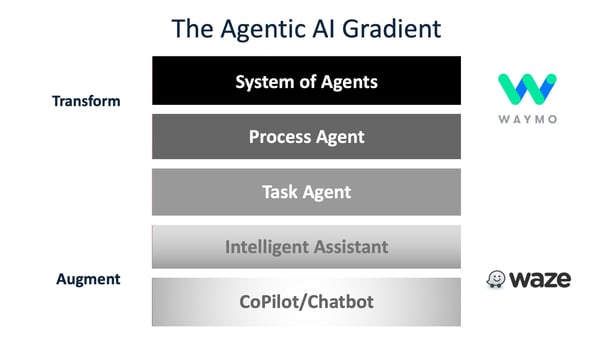What if the cost of prediction decreased? Prediction, as you know, is not just seeing the present but also the future, whether five seconds from now or five years from now.
Artificial intelligence can be thought of as a prediction machine because it takes information you have and delivers information you don’t have.
Historically, prediction has been extremely expensive, but that’s no longer true. In the world of tech, prediction used to require armies of engineers and proprietary data, but now LLMs offer off-the-shelf solutions at a fraction of the cost. As I shared at Reach Europe 2025, the falling cost of prediction – much like the dramatic drop in the cost of artificial light a century ago when the lightbulb was invented – is creating unprecedented opportunities for innovation and entrepreneurship.
To stay competitive in such a fast-paced environment, European (and global) businesses should monitor these three AI mega-trends.
1. The agentic AI revolution in Europe
Despite concerns that privacy regulations throughout Europe might impede agentic AI adoption, my research indicates quite the opposite. Venture capital firms specifically in the United Kingdom and throughout Europe – including Join Capital, Octopus Ventures, HP Capital, Runa Capital, Episode 1 Ventures, and Teacher Venture Growth – are actively investing in agentic AI startups across the region.
There are already nearly two dozen promising agentic AI startups in Europe, with several emerging from Y Combinator. One standout example is LightOn, a French startup making significant headway in banking, defense, and high-tech markets. These developments signal that the agentic AI explosion isn't limited to Silicon Valley. It's a global opportunity that European entrepreneurs are perfectly positioned to capitalize on.
Understanding the agentic gradient
When discussing agentic AI, I've found it helpful to frame the technology as existing on a gradient. This gradient runs from "Waze to Waymo" – from systems that augment human capabilities to those that truly transform operations by performing without humans.

At the lower end of the gradient are copilots and chatbots, which make recommendations but require humans to execute them. Like how Waze makes driving recommendations based on traffic, but the driver ultimately drives the car. Moving up, we see intelligent assistants with more reasoning capabilities and access to external tools. Task agents – which can complete specific actions independently – represent the next level, with several European companies like topo.io out of France developing sophisticated agentic sales development representatives.
Moving up the gradient, next comes process agents that leverage decision intelligence and can navigate dynamic environments. Finally, at the top of the gradient are Systems of Agents, which can collaborate with other agents to deliver intensive and highly complicated workflows, taking you from need to destination. An example of this is Waymo, the system of cars launched by Google that can deploy a fleet of self-driving taxis.
Agentic AI is a trend I’m particularly excited about. We should all be watching closely and exploring how we can put these innovations to work for our businesses.
2. The answer economy takes hold in the UK
Perhaps most striking in my recent research is how quickly the "answer economy" is taking root in Europe, particularly in the United Kingdom. Traditional search – based on SEO and page rankings – is rapidly giving way to generative AI search that delivers answers rather than links. These LLMs aren’t tuned the same way traditional search engines are, and they don’t have a business model that requires monetizing results and cluttering the user experience.
The statistics are remarkable: traffic from generative AI sources like ChatGPT and Perplexity to retailers rose tenfold in the UK between July and September 2024 alone. While traditional search still accounts for 98% of all queries in the UK, this reminds me of being at Yahoo when Google emerged – it wasn't a big deal until suddenly it was, disrupting the entire market and taking half our traffic within just a few years. And think of software buyers, who are usually early adopters of any new tools that can make them more productive. G2 research found that a third of them report that search was a bottleneck in their buying journey.
For European businesses, this shift requires new strategies. Implementing Generative Engine Optimization (GEO) to restructure website content around answering questions rather than just marketing products will be crucial. Additionally, being proactive about content distribution and investing in user-generated content that comprehensively answers complex problems will help companies show up more frequently in large language model results.
3. AI adoption: Focus on utilization
While the opportunities for AI are immense, research shows that European businesses, like their global counterparts, must focus intently on driving utilization to realize their return on investment. According to G2's analysis, AI buyers expect to achieve ROI within six months, but the key to ROI isn't implementing AI faster – it's increasing adoption rates. With this in mind, sellers must stay laser-focused on utilization in order to prevent customer churn.
This is why at G2, when we review AI products, we now specifically ask reviewers about their utilization rate for AI tools. This data helps both buyers and sellers understand what's working and what isn't. For European businesses selling AI solutions, making utilization management a top priority – pursuing integrations, leveraging screen vision technologies, and focusing on reducing "quitting cost" – will be essential to success.
How to stay ahead of these trends
As the cost of prediction continues to fall, European businesses have an unprecedented opportunity to reinvent themselves. Whether it's French startups developing sophisticated agents for banking or UK retailers embracing the answer economy, Europe is demonstrating that it won't be left behind in the AI revolution.
For business leaders looking to stay ahead of these trends, my advice is simple: invest now in understanding and implementing agentic AI, prepare for the shift to the answer economy, and focus relentlessly on driving utilization. The companies that do these things well won't just survive the AI transformation – they'll lead it.
The future of AI isn't just being written in Silicon Valley. It's being written in London, Paris, Berlin, and dozens of other European innovation hubs. And at G2, we're committed to being your trusted source of research as this exciting story unfolds.
If you missed it, you can view my full session on “The 3 AI-Mega Trends We’re Watching at G2” and access every session from Reach on-demand here.
 by Ross Briggs
by Ross Briggs
 by Tim Sanders
by Tim Sanders
 by Paul Gilhooly
by Paul Gilhooly